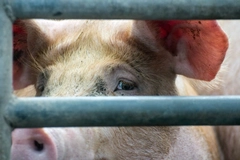
- Industry news
Industry news
- Category news
Category news
- Reports
- Key trends
- Multimedia
- Journal
- Events
- Suppliers
- Home
- Industry news
Industry news
- Category news
Category news
- Reports
- Key trends
- Multimedia
- Events
- Suppliers
ConAgra Reports Strong Third-Quarter EPS Driven by Continued Growth for Consumer Foods Segment

Diluted EPS from continuing operations of $0.50 as reported, and $0.44 excluding items impacting comparability; up 16% as reported and up 10% on a comparable basis.

26 Mar 2010 --- ConAgra Foods, Inc., one of North America's leading packaged food companies, reported results for the fiscal 2010 third quarter ended Feb. 28, 2010. Diluted EPS from continuing operations was $0.50 compared with $0.43 a year ago. Current quarter results include $0.06 per diluted share of benefit, while prior-year amounts included $0.03 of net benefit, from items impacting comparability. Diluted EPS from continuing operations on a comparable basis was $0.44, up 10% from comparable amounts in the year-ago period.
Items impacting comparability in the current year and prior year are summarized toward the end of this release.
Gary Rodkin, ConAgra Foods' chief executive officer, commented, "We are pleased to report another good quarter where comparable EPS growth was primarily driven by profit improvement for our Consumer Foods segment. The continued momentum in our sales, innovation, marketing, and cost-savings initiatives is generating the second-half results we expected. As we discussed in our recent presentation to the Consumer Analyst Group of New York, we are confident that our strong business foundation has positioned us for sustainable profitable growth."
Consumer Foods Segment (65% of Year-to-date sales)
Branded and non-branded food sold in retail and foodservice channels.
The Consumer Foods segment posted sales of $2,034 million and operating profit of $306 million for the quarter. Sales increased 2% and unit volumes increased 3%, reflecting the benefit of ongoing innovation, marketing, and customer service initiatives. Foreign exchange favorably impacted sales growth by 1%. Sales growth was slower than unit volume growth due to slotting and couponing connected with new product launches, as well as lower prices for cooking oil and related items due to the pass-through of lower cooking oil costs.
* Large brands that posted sales growth include Banquet, Chef Boyardee, Hunt's, Marie Callender's, PAM, and others.
* More brand details can be found in the Q&A document accompanying this release.
Operating profit of $306 million was 25% ahead of last year's $245 million; current-quarter amounts include a gain of approximately $14 million from the sale of the Luck's brand. Excluding this gain, current-quarter segment operating profit was $292 million, up 19%. The strong year-over-year profit improvement reflects a more favorable input cost environment, strong productivity savings, and good sales results. These factors enabled a $12 million increase in advertising and promotion investment during the quarter. Due to progress with the ongoing recovery of the Slim Jim business, the company notes that year-over-year differences in sales and profits for that product line did not significantly impact the segment's sales or operating profit comparisons for the third quarter. See page 8 for a Regulation G reconciliation of operating profit.
Commercial Foods Segment (35% of Year-to-date sales)
Specialty potato, dehydrated vegetable, seasonings, blends, flavors, and milled grain products sold to foodservice and commercial channels worldwide.
Fiscal third quarter sales for the Commercial Foodssegment were $1,062 million, 6% below last year's $1,134 million; the decrease was driven by lower flour milling sales that reflect the pass-through impact of lower underlying wheat costs. Segment operating profit was $149 million, 6% above last year's $141 million. Lamb Weston profits improved on a modest increase in sales, reflecting the positive impacts of higher prices necessitated by increased input costs, as well as plant efficiencies and improved mix. Lamb Weston's sales and profit growth continued to be negatively impacted by difficult food service industry conditions. Flour milling profits remained strong, reflecting continued excellent operational efficiencies and favorable wheat market conditions; as expected, current-quarter milling profits were below the very strong amounts earned in the year-ago period. Profits for the rest of the segment were marginally above year-ago amounts.
As previously discussed, the company expects full-year fiscal 2010 Commercial Foods segment operating profit to be in line with fiscal 2009 amounts. Full-year operating profit estimates for the Commercial Foods segment reflect plans that fiscal fourth quarter operating profit will be below year-ago amounts; this is largely driven by the absence of a 53rd week, the impact of a cost allocation process change at Lamb Weston discussed earlier in the year, and the expected continuation of a difficult foodservice environment.










